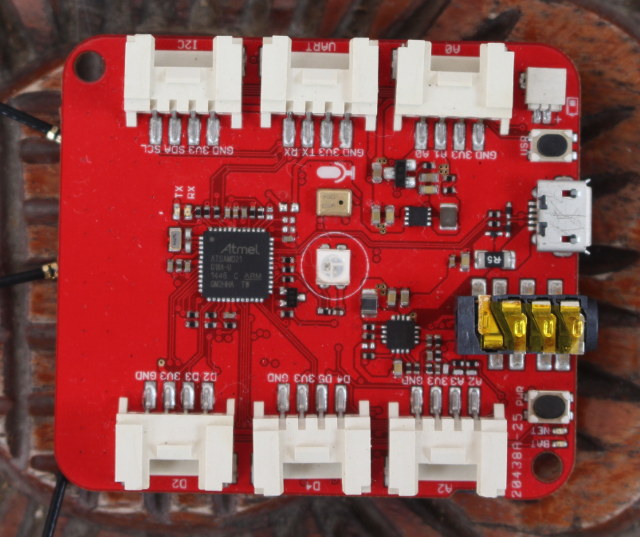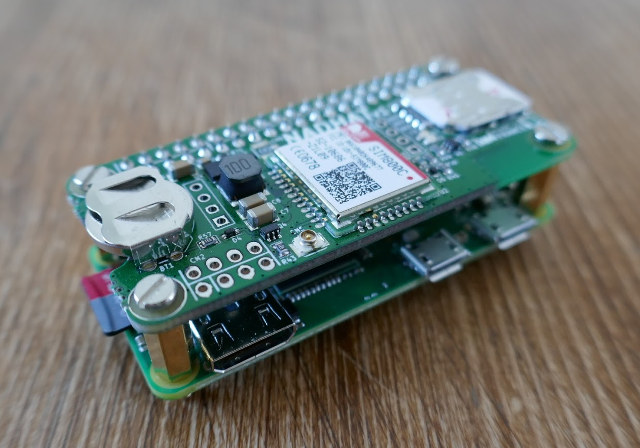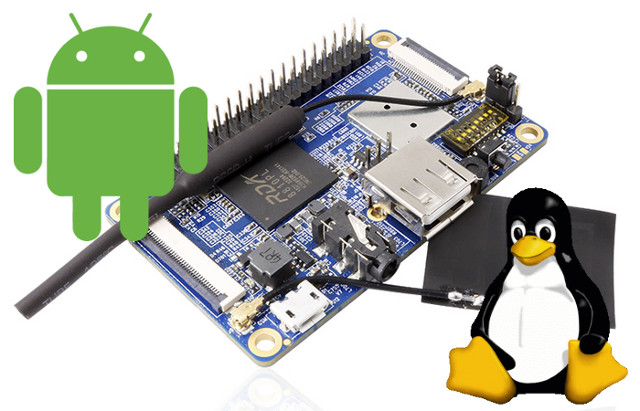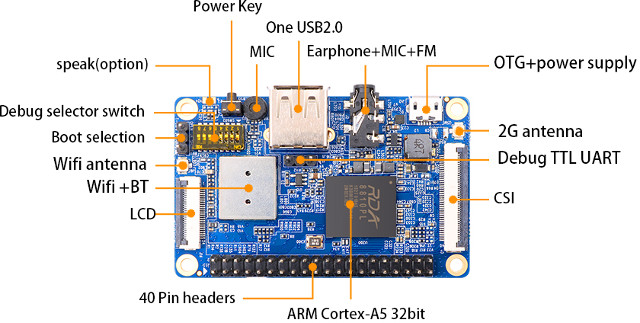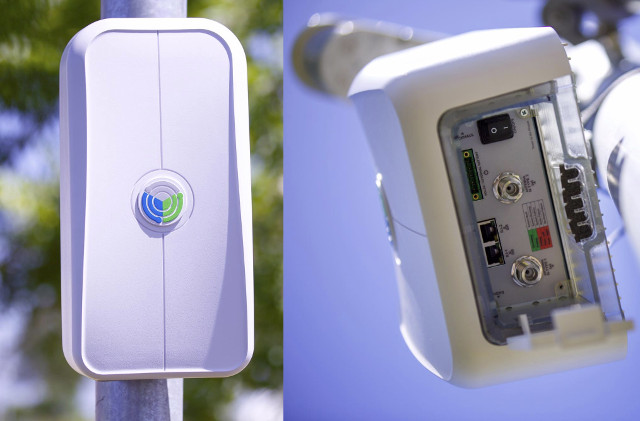Wio GPS – also called Wio Tracker – is an Arduino compatible board based on Microchip Atmel SAMD21 MCU with GPS, Bluetooth, GSM/GPRS connectivity, as well as several Grove connectors to connect sensors and modules for your IoT project. SeeedStudio sent me a sample for evaluation, so I’ve tested it, and reported my experience below by testing some of the Arduino sketches. Wio Tracker Unboxing All I got in the package was Wio GPS tracker v1.1 board. The top includes the Atmel MCU, an RGB LED, a microphone and 3.5mm AUX jack to make phone calls, a user and power button, a micro USB port for power and programming, a small 2-pin connector for a battery, and 6 Grove connectors for digital, serial, I2C and analog modules. The other side of the board comes with Quectel MC20 module that handles Bluetooth, GPS and GSM, a dual use micro SD card […]
Nadhat is an Add-on Board for Raspberry Pi Boards with 2G GSM/GPRS Support
Making Raspberry Pi HATs for fun seems to have become a popular hobby, as after checking out Leon Anavi’s Infrared pHAT a little while ago, I’ve just come across Nadhat add-on board with GSM/GPRS and Bluetooth 3.0 made by Frederic Pierson in his spare time. Nad stands for “Network Access Device”, and the device comes with the following specifications: SIM800C module with 2G GSM/GPRS support, and Bluetooth 3.0 + EDR (but Bluetooth is not mentioned by the developer, so it may not work right now) SIM card slot + connector for GSM antenna CR1225 cell battery slot for RTC 40-pin header provided, but not soldered Dimensions – 65 x30 mm, compatible with Raspberry Pi Zero He explains that he made the board himself and the PCBs “are leaded reflow processed and do not follow regulations in Europe”. You’ll also have to provide your own GSM antenna and CR1225 battery. He’s […]
Wio GPS is a $40 Grove & Arduino Compatible Bluetooth 3.0 + GSM/GPRS + GPS Tracker Board
After Wio Link and Wio Node boards, Seeed Studio has added a new board to their Wio (Wireless Input Output) family with Wio GPS board based on Microchip SAMD21 Cortex M0+ MCU for Arduino compatibility, and Mediatek MT2503 ARM7 processor for GPS, Bluetooth 3.0, and 2G (GPRS) connectivity. Wio GPS board specifications: MCU – Microchip ATSAMD21G18A-MU ARM Cortex M0+ MCU @ 48 MHz with 256KB flash, 32KB SRAM Wireless SoC – Mediatek MT2503 ARM7EJ-S processor @ 260 MHz Storage – micro SD slot (shared with nano SIM slot) Connectivity (built-in MT2503 in Quectel MC20 module) Bluetooth 2.1 + EDR, 3.0 with SPP Profile and HFP-AG Profile; u.FL connector for external antenna Quad band 2G GSM/GPRS with u.FL connector for external antenna and nano SIM card slot GNSS – GPS + BeiDou + QZSS with u.FL connector for external antenna Audio – Speaker footprint (+/-), 3.5mm AUX jack with mic and stereo audio […]
RDA Micro RDA8810 Android SDK with Linux & U-boot Source Code for Orange Pi 2G IoT Board Released
Orange Pi 2G IoT board was released a couple of weeks ago, shortly followed by Android and Ubuntu images, but since it was not based on Allwinner, but an RDA Micro 8810PL processor, we did not have any source code so far, which can be a real problem for a development board… Shenzhen Xunlong has now managed to upload a 6.7GB Android SDK to MEGA, with the link published via Orange Pi Resources page. MEGA has a download limit which depends on how much traffic they get at the time, and after 5.3 GB download, I was asked to register for a PRO account, or wait for four hours before resuming the download. If you want to avoid this limit for any large MEGA download, you can run megadl instead. That’s what I did in Ubuntu 16.04 (remember to escape any special characters with \):
|
1 2 |
sudo apt install megatools megadl https://mega.nz/#F\!59EVmKAZ\!5FdBb2dQIMcxgY2h16nGPg |
Once the download is […]
Particle Asset Tracker Kit v2 2G/3G GPS Location Tracker Supports Grove Modules
Particle, the maker of IoT boards such as Electron 2G/3G module, has launched it second Asset Tracker Kit – based on Electron – with a smaller case, improved GPS performance, satellite support for GPS, GLONASS, Galileo & BeiDou, and compatibility with Seeed Studio Grove modules. Asset Tracker Kit v2 hardware specifications: MCU – STMciro STM32F205 ARM Cortex M3 micro-controller @ @ 120 MHz with 1MB Flash, 128K RAM Cellular Connectivity – U-Blox SARA U-series (3G) or G-series (2G) modem + NanoSIM card slot + u.FL connector for Antenna Location 72-channel u-bloxM8 engine with support for GPS/QZSS L1 C/A, GLONASS L10F, BeiDou B1I, Galileo E1B/C, SBAS L1 C/A: WAAS, EGNOS, MSAS, GAGAN Update rates: Single GNSS: up to 18 Hz, 2 Concurrent GNSS: up to 10 Hz Position accuracy of 2.5 m, sensitivity of -167 dBm Acquisition times: Cold starts: 26s, Aided starts: 2s, Reacquisition: 1s On board ceramic GPS antenna […]
Orange Pi 2G-IoT ARM Linux Development Board with 2G/GSM Support is Up for Sale for $9.90
Orange Pi 2G-IoT was unveiled at the start of the year as an ultra cheap ($10) Linux development board with 2G cellular connectivity. The board has just launched for $9.90 + shipping on Aliexpress. Orange Pi 2G-IoT specifications have changed a little since the initial announced as WiFi is confirmed to be supported: SoC – RDA Micro 8810PL ARM Cortex A5 processor @ up to 1.0 GHz with 2Gbit (256 MB) on-chip LPDDR2 RAM, 4Gbit (512 MB) on-chip SLC NAND flash , 256KB L2 cache, Vivante GC860 3D GPU, and GSM/GPRS/EDGE Modem (Download datasheet) External Storage – micro SD slot Display I/F – LCD connector up to qHD resolution Video – Decoding up to 1080p30, encoding up to 1080p30 H.264 Audio I/F – 3.5mm audio +FM jack, built-in microphone? Connectivity – WiFi 802.11 b/g/n + Bluetooth 2.1/EDR module (RDA5991), and 2G GSM/GPRS/EDGE module with SIM card slot Camera – MIPI […]
$99 Ping is a Tiny GPS Tracker that Works with Bluetooth and Cellular Connectivity (Crowdfunding)
Ping GPS Tracker is really small, last several months on a charge, and works with GPS, Bluetooth, and Cellular (GSM/EDGE or HSPA/UMTS) connectivity. It helps you track kids, pets, bags, keys, bicycles, cars or anything that may be lost or stolen using your iOS or Android smartphone. Ping GPS tracker specifications: Connectivity HSPA/GSM module + embedded 3G module Bluetooth Low Energy module GPS + GLONASS module Sensor – 3-axis accelerometer Misc – Inset tactile button for check-in & SOS, LED activity indicator Battery – 300 mAh custom lithium ion battery good for about 3 months Dimensions – 34 x 34 x 12 mm (PMMA silicone & elastomer materials) Weight – About 30 grams Waterproof – Up to 10 meters You’d use GPS + cellular connectivity when you are far from the tracked asset, and Bluetooth to locate it when it’s close. A button allows for your kid to send a […]
OpenCellular is Facebook’s (soon to be) Open Source Wireless Access Platform
A few months after Canonical and Lime Micro LimeSDR open source software defined radio aiming to be used as a development platform, but also as the base for low cost cellular or other wireless base stations, Facebook has announced their own open source wireless access platform with OpenCellular project whose goal is to lower the cost of Internet connectivity in remote areas where the infrastructure does not exist. This is how Marc Zuckerberg summarizes the project: We designed OpenCellular as an open system so anyone — from telecom operators to researchers to entrepreneurs — can build and operate wireless networks in remote places. It’s about the size of a shoe box and can support up to 1,500 people from as far as 10 kilometers away. Along with our solar-powered aircraft Aquila and high-bandwidth laser beams, OpenCellular is the next step on our journey to provide better, more affordable connectivity to […]


